From Gray to Green
The sewerage district has moved from tunnels and pipes to greenways, rain barrels and permeable pavement. Part 2 of a series.
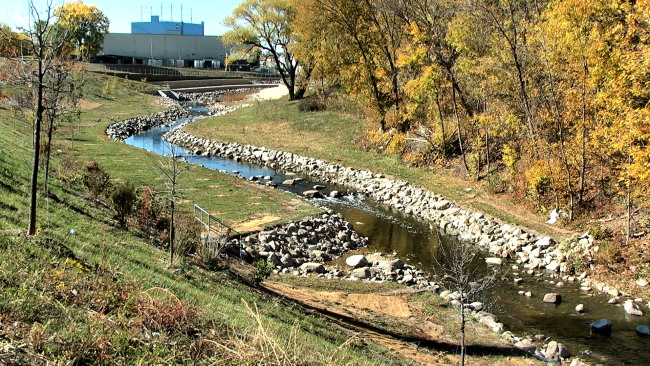
The cement liner has been removed from the segment of the KK River at S. 6th St. Photo courtesy of MMSD.
Developing green infrastructure in the city can also include undoing what was once considered state-of-the-art stormwater management. In the 1960s, flooding along the Kinnickinnic River was resolved by laying a cement liner under the river. It quickly channeled storm water to the treatment plant, but it also prevented that water from being absorbed into the ground. The channel worked temporarily, but failed as increasing amounts of water came in the system. It turned into an ugly, dirty, trash-filled stream that was a health and safety hazard for the neighborhood. To solve that problem, MMSD not only had to remove the lining, it would also have to tear down 84 houses in the flood plain.
To prepare the community for this massive interruption, MMSD approached the Sixteenth Street Community Health Center. The agency, started in 1969, currently serves about 35,000 people. In the 1990s, says its Community Engagement Specialist Iris Gonzelez, the city’s Department of Environmental Health was developing a lead abatement program, and Sixteenth Street became a partner because its sustainable development program focused on the built environment where patients live. About 8,000 people live within the the KK watershed in the city. The work on that river, according to Gonzalez, “will improve health outcomes and quality of life” for the people who live near it.
Nadia Bogue, Sixteenth Street’s Environmental Projects Coordinator, describes the area as the most densely populated census tract in the city. About 71 percent of its residents are Latino and 38 percent are under 19. The first stage of the work focused on a residential area between S. 6th and S. 16th Streets, where about half of the 84 houses that MMSD needed to tear down were owner occupied.
The neighborhood, says Bogue, got involved in the project in 2005. The removal of the cement liner and the clean up and redesign of the riverbanks helped revitalize the area. The KK River Neighbors in Action was formed and 15 residents went through community leader training and created a neighborhood association. Ultimately, says Gonzales, the community “can become the stewards of this.”
In Shafer’s vision, MMSD’s work isn’t to just fix a flood problem, but to leverage the District’s resources and facilitate the work of complementary groups who, like MMSD, are working to improve the quality of life for residents of Milwaukee. “If I’m going to build a path for a small truck to drive on then I’m going to make that a path for a bicycle, person or a pedestrian to walk on,” he says.
That kind of approach involves collaboration both large and small. For the KK River project, MMSD staff went to every single public meeting because, according to Bogue, “Sixteenth Street doesn’t want to answer questions on MMSD’s behalf.” Shafer came to one of the first public meetings she organized in September 2012. “He didn’t announce himself,” she remembers. “He stood in the back. He was silent. He listened to residents’ concerns.”
Dave Fowler, Senior Project Manager was one of those people canvassing the KK River neighborhoods. He’s been with MMSD for 35 years and says that Shafer is his favorite executive director. (Marchese is his next favorite.) Shafer brought leadership and guidelines to the District, Fowler says, adding, “At every single public meeting, he identifies and credits staff members.” Gonzalez and Borque remember that he let his staff handle residents’ questions, and when he did introduce himself, it wasn’t as MMSD’s Executive Director, but as an employee.
The biggest issue was that MMSD was going to take people’s houses. “I personally met with or called every person who was having a house torn down,” says Fowler, so “they had a face they could yell at.”
Borgue notes that Fowler handed out his cell phone number, so the residents could always reach him. One of their concerns was the presence of boarded-up houses in their neighborhood. Because there were so many houses that needed to come down and they wanted to provide jobs for the community, explains Fowler, the MMSD decided it would be more cost effective to put more houses in each subcontractor’s bid package. But waiting until they’d accumulated enough for the bid package was bad for the neighborhood that was living with boarded-up properties, and the complaints drove up administrative costs. So they rewrote the bid so that the houses would be demolished as they were acquired.
“Residents were thrilled,” says Bogue.
“Now,” adds Gonzalez, “when they see a house that’s boarded up, they know there a quick timeframe” before it comes down.
The partnership with MMSD, says Gonzalez, has worked well for the community Sixteenth Street serves. Adds Bogue: “MMSD has been a fantastic partner in being clear about what they can do, and being open to hearing about other related opportunities.”
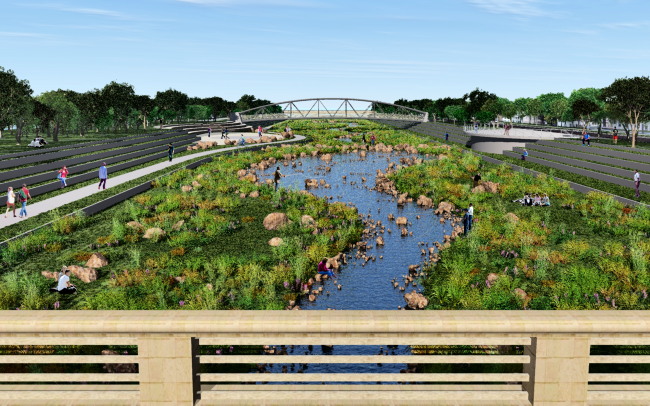
A rendering of what the KK River, from S. 6th St. to S. 27th St., will look like once the cement liner is removed. Rendering courtesy of MMSD.
But the project is complicated and has a long time line. “They’ve been involved since 2005 and it won’t be completed until 2035,” notes Gonzales. “The community has been very patient.” The goal, she adds, is for the community to take over once MMSD is done. “Ultimately, we can become the stewards.” The strength of Sixteenth Street’s partnership with MMSD is the reason for that success. “They really get it,” Gonzales says.
“Everything we do,” says Shafer, “we have to work with partners and that just makes everything better.” Working well with partners is a necessary achievement for any water utility that wants to not only meet current demands for clean water, but continue to do so in the future. This change in thinking, from gray to green, from sole operator to one partner among many is “an evolution of a city, not a revolution,” says Neukrug, the Philadelphia water commissioner. “We need to do things slowly because we’re looking at managing water a whole new way.”
In working towards MMSD’s goals, Shafer pushes others as well. Kimberly Gleffe, Executive Director of the River Revitalization Foundation, recruited Shafer to her group’s board several years ago because of his association with the Greenseams program. The River Revitalization Foundation is a land trust—they buy parcels of land along the river. They currently help maintain 880 acres of riparian corridor on both sides of the Milwaukee River between North and Capital. When Kevin joined RRF’s Board five years ago, he pushed the nonprofit to become part of the Southeast Wisconsin Watershed Trust, known as Sweetwater. At the time, says Gleffe, Sweetwater was “all water quality,” but Kevin convinced them that they needed to know how the land impacts the water quality. “For six years, we were part of that [Sweetwater] because he insisted that we were at the table,” says Gleffe. “He was making that land and water connection.” Once Shafer sets his sights on something, says Gleffe, he pushes everyone around him to achieve that goal.
At the DNR, Rasmussen has worked with MMSD for 12 years and says that, “They’re not just focused on their own job, but on what else they can do for the community.” Like Korban, Rasmussen is a little surprised to have such a collaborative relationship with an agency he regulates. Their biggest project is the permit for wastewater discharged by MMSD, and rather than a rancorous bargaining process, Shafer offered more than the DNR asked for: “There were all these other things that Kevin was willing to add into their permit,” Rasmussen says.
Most of those additions by MMSD involved the Greenseams and infrastructure projects. Adding requirements to MMSD’s permit allows Shafer to push the utility in the direction he wants it to go, but it also restores the idea that clean water is about health. In the past, he says, the emphasis was on “meeting the permit requirement,” and that tug of war resulted in a failure to address the underlying purpose of the requirements — to insure the District protects the water now and for the future. An emphasis on fishable, swimmable waters that contribute to the region’s economic vitality are “part of the new discourse,” says Shafer.
Flood management wasn’t in MMSD’s permit, he notes, but MMSD was doing the work because, “it makes sense to keep floods out of people’s basements.” They were already doing the work for Greanseams so they wanted to make it count by adding it to the permit. Collaborating in the process also saves money over the long haul. In 2011 and 2012, says Shafer, DNR wanted MMSD to start treating storm water outfalls (non-point source) because they are a major contributor to high levels of bacteria in the water, but that was too expensive. By focusing on the goal—cleaning the water—rather than the rules of the permit, MMSD was able to offer Greenseams as an alternative and enlist community partners like Poblocki Paving to help them meet their goals.
Ben Grumbles, Secretary of the Environment for the State of Maryland and the former president of the U.S. Water Alliance, which awarded MMSD their U.S. Water Prize in 2013, offers (via email) this assessment of the group: “MMSD is a national leader in collaboration and innovation. They embody a model ‘water utility of the future’ that thinks beyond the pipe and fence line and into the broader watershed of their communities.”
Yet back in Milwaukee, as one local environmentalist points out, the MMSD, despite its good work, is “just not feeling the love.” But maybe that’s good, she adds: “they’ll just keep trying harder.”
Article Continues - Pages: 1 2
Political Contributions Tracker
Displaying political contributions between people mentioned in this story. Learn more.
- December 1, 2020 - Tom Barrett received $500 from Kevin Shafer
- June 25, 2018 - Tom Barrett received $100 from Ghassan Korban
- April 1, 2018 - Tom Barrett received $400 from Kevin Shafer
- December 15, 2017 - Tom Barrett received $400 from Kevin Shafer
- January 31, 2016 - Tom Barrett received $400 from Ghassan Korban
- October 14, 2015 - Tom Barrett received $400 from Kevin Shafer
The MMSD Story
-
Every Drop Counts
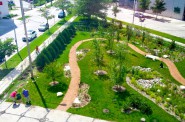 May 28th, 2015 by Susan Nusser
May 28th, 2015 by Susan Nusser
-
How The Sewerage District Came of Age
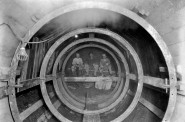 May 13th, 2015 by Susan Nusser
May 13th, 2015 by Susan Nusser

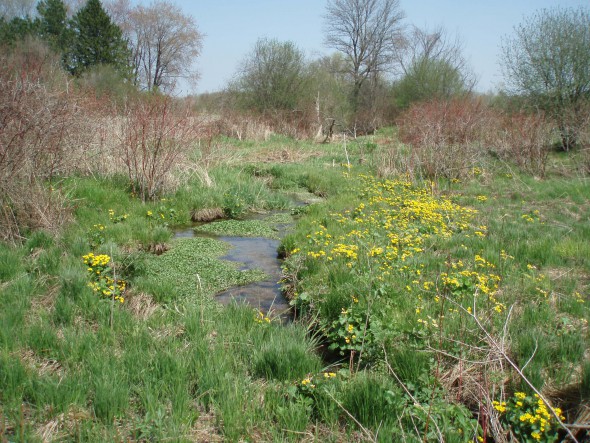















Excellent! I hope the plan is to remove the liners from every stream, creek and river in the watershed. Tear down buildings that are too close, restore river banks and native plants. Tear out the dams, let the fish be free. Require all new pavement to be permeable, at least in parking lots if streets and highway can’t be. At least until better pavement technology allows for them as well.
I grew up in a woodland that had a spring fed creek. The water was so pure we could drink it. I hope the springs in Milwaukee can be that way again too.
The critical work the MMSD has undertaken is a phenomenal success story of good old fashinoned common sense combined with hard work and real vision. I live in Dane County and in the Village of Maple Bluff a short block or so from the Governor’s Mansion and Lake Mendota. Over the years you eventually catch on that the environment of a neighborhood certainly affects the property value of the neighborhood. The better the environment the greater the value of the neighborhood’s properties. What is so exciting about what is happening in Milwaukee is not only that potential benefit to all property values…but the tremendous health benefits that go along with the cleaner,greener more sustainable neighborhood. So smart and so important. MMSD it’s staff and commissioners are to be commended and encouraged to keep up the fight. Very good article. Much appreciated information.
Kudos to Kevin! removing liners must continue.